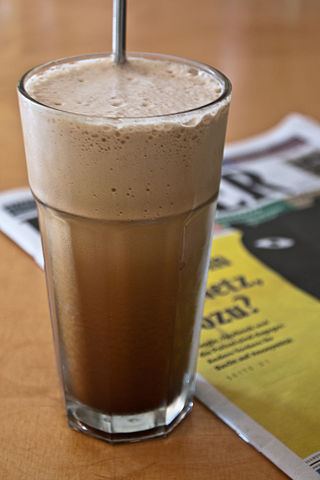Top Qs
Timeline
Chat
Perspective
Frappé coffee
Greek iced coffee drink From Wikipedia, the free encyclopedia
Remove ads
A frappé coffee, cold coffee, Greek frappé, or just frappé (Greek: φραπέ, frapé [fraˈpe]) is a Greek iced coffee drink generally made from spray-dried instant coffee, water, sugar, and milk.[1] The word is often written frappe (without an accent). The frappé was invented in 1957 in Thessaloniki[2][3][4][5] through experimentation by Dimitris Vakondios, a Nescafe representative. Greek Christos Lenzos (1930–2023),[6][7] a coffeehouse (1964–2013) owner in Pangrati, has been recognized for his self-made version of Greek frappé coffee. Frappés are among the most popular forms of coffee in Greece and Cyprus and have become a hallmark of postwar outdoor Greek coffee culture.
Remove ads
History
Summarize
Perspective
The name frappé ('punched', figuratively 'shaken') comes from French, which describes drinks chilled with ice.[8] Beginning in the 19th century, a variety of cold coffee drinks named café frappé (à la glace) are documented, some similar to slushies[9][10] and others more like iced coffee.[11]
The Greek version of café frappé, using instant coffee, was invented in 1957 at the Thessaloniki International Fair. A representative of the Nestlé company, Giannis Dritsas, was exhibiting a new product for children. It was a chocolate beverage produced instantly by mixing it with milk and shaking it in a shaker. Dritsas' employee, Dimitris Vakondios, was looking for a way to have his usual instant coffee during his break but could not find any hot water, so, he mixed the coffee with cold water and ice cubes in a shaker.[5][12]
This improvised experiment established the frappé which quickly grew in popularity in Greece. Nestlé capitalized on the drink with intense marketing campaigns in the 1980s that broadened the drink's popularity and left the brand name Nescafé inextricably linked with the frappé.[5] Today, the drink is usually simply called a 'frappé' in Greece, but in the past, it was often called a 'Nescafé frappé'.[13][14][15]
Remove ads
Preparation
A frappé can be made with a cocktail shaker or, more commonly today, with an electric milk frother or milkshake machine. First, instant coffee (traditionally Nescafé), sugar (optional), and a little water are shaken or blended together until a thick foam is made.[16] This is then poured into the serving glass with ice cubes and cold water. Milk (traditionally evaporated milk or sometimes condensed milk) is optionally added to it. The drink is almost always served with a drinking straw as the thick foam formed on top is considered unpleasantly bitter by many.[1][5][17]
Remove ads
Frothy top

The spray-dried instant coffee used to make a frappé contains nearly no oil and this allows the frappé's characteristically thick layer of foam to form. Frappé foam is similar to crema, the foam found in espresso, but thicker and longer lasting due to its oilless composition. It is a three-phase colloid of air bubbles, coffee solids, and water. Depending on the initial size of the foam's bubbles and the frappé's sugar content, water drains from the foam over the course of 2–10 minutes. It will thicken until it forms a nearly solid foam, which then slowly dissipates. Frappés made with freshly brewed coffee or freeze-dried instant coffee, both of which contain significantly more oils than spray-dried instant coffee, produce only short-lived foams.[1] Moreover, the method of preparing the frappé can impact the bubbles on top of the coffee. For example, making a frappé by using a handheld shaker produces finer, longer lasting, and more stable bubbles.[1]

Terminology and variations
Summarize
Perspective
In Greece, a frappé is generally ordered by specifying sweetness and the option to add milk. For 2 spoonfuls of coffee, the usual sweetness levels are the following:
- glykós (γλυκός [ɣliˈkos] 'sweet') – 4 spoonfuls sugar
- métrios (μέτριος [ˈme.tri.os] 'medium') – 2 spoonfuls sugar
- skétos (σκέτος [ˈsce.tos] 'plain') – no sugar
Milk, usually evaporated milk, is generally not added unless explicitly requested by using the phrase me gála (με γάλα [me ˈɣala] 'with milk'); likewise, it can be explicitly requested without milk by saying horís gála (χωρίς γάλα [xoˈris ˈɣala], 'without milk').[5][17]
A frappé with milk is occasionally called frapógalo (φραπόγαλο [fraˈpoɣalo] 'frappé-milk'). Sometimes, particularly in Cyprus, frappés are made with milk instead of water (besides the water used in the foam). At some establishments, particularly beach bars, alcoholic liqueurs such as Kahlúa or Baileys Irish Cream are added to frappés. Other restaurants offer adding a ball of vanilla ice cream to a frappé instead of milk.[1][18][19] Though not technically frappés (since they are not shaken), some variations are stirred with a spoon when a shaker is not available and this creates a different texture and taste. These variations are generally referred to as koutalátos (κουταλάτος [kutaˈlatos], lit. 'spoon-made') or karavísios (καραβίσιος [karaˈvisios], lit. 'of the ship') because of their association with sailors at sea.[citation needed]
Freddo Espresso and Freddo Cappuccino
The freddo espresso is a Greek iced espresso which was first made in Athens in 1991 and has grown in popularity since. It is often seen as a "higher quality frappé".[20] The freddo cappuccino is a freddo espresso topped with a cold milk-based foam called afrógala (Greek: αφρόγαλα).
Outside Greece
Although frappés are commonly associated with Greece, their popularity has grown in other nations in the recent years. Frappés first became broadly known outside of Greece during the 2004 Summer Olympics in Athens, wherein many tourists became fond of them and an article was published in the Los Angeles Times.[17] Immigrants and tourists in Greece have also helped to take the frappé abroad.
Remove ads
See also
References
Bibliography
Wikiwand - on
Seamless Wikipedia browsing. On steroids.
Remove ads

